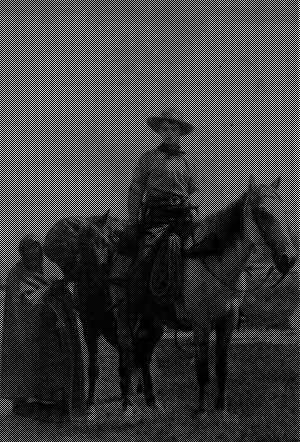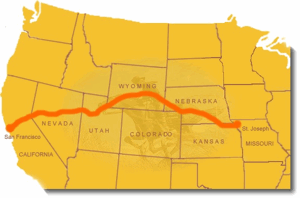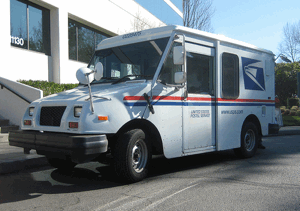The Postman Rings Greener
Air Date: Week of March 26, 2010

A Pony Express rider (Courtesy of the National Archives)
April 3rd marks the 150th anniversary of the famed Pony Express. Just as that first overland mail delivery was replaced by the telegraph, today's postal service is struggling to stay in business as e-communications become the norm. The USPS is exploring the possibility of eliminating Saturday delivery to save money. Sam Pulcrano, vice president of sustainability for the postal service, explains to host Jeff Young how one day less would affect the USPS’s carbon footprint.
Transcript
YOUNG: It’s Living on Earth, I’m Jeff Young.
[HORSE GALLOPING SOUNDS]
YOUNG: April 3rd marks 150 years since the first ride of the Pony Express. And the anniversary carries a timely lesson for us today. The Pony Express was the first over land route to transport mail from the East Coast to California.
Trains carried mail to St. Joseph, Missouri where riders—some as young as 13—carried it by horseback to Sacramento, California. Cindy Daffron, director of the Pony Express Museum in St. Joseph, says it was one tough mail route.

The Pony Express went from Missouri to California. It was the first land route across the United States to deliver the mail. (Courtesy of the Bureau of Land Management)
DAFFRON: If you’ve been around a horse you know at a full gallop they are a 20-mile-an-hour animal and we know they can’t keep that up for any period of time. So we say more of an average is ten to 12 miles per hour.
Now every seven to 15 there would have been what we call a relay station. Some kind of a building with a spare horse there and that guy would have been responsible to take care of the horse, wait for the rider to come in, get him exchanged. Two minutes is all they designed for those guys to get off one horse, and head out.
YOUNG: As famous as the Pony Express is, it went belly-up after only a year and a half. Mail by pony could not compete with the telegram. Today’s postal service also faces stiff competition from electronic communication. The USPS could be hundreds of billions of dollars in debt in the coming decade, so it’s looking to save money by cutting Saturday delivery and using less fuel.

A Pony Express rider (Courtesy of the National Archives)
[SOUNDS OF VAN MOVING]
YOUNG: Everett, Massachusetts, letter carrier Wayne Post delivers with alternative fuel.
POST: I drive a Dodge van. But it’s a flex fuel vehicle. It uses regular gasoline and it uses the flex fuel, it’s an eco-friendly type of fuel that they have on the vehicles, the newer ones. Let’s go fill up.
[TANK AND GAS FILLING SOUNDS]
YOUNG: The Postal Service is doing more than trimming its budget this way. It’s also reducing its carbon footprint. It’s Sam Pulcrano’s job to keep track of such things. He’s vice president of sustainability for the USPS.
PULCRANO: We already have one of the largest alternative fleets in the world, about 44,000 vehicles. We have vehicles out there running on CNG, propane, electric vehicles, as well as hydrogen fuel cell vehicles. And just very, very recently we just awarded a contract to five different companies to take that current vehicle—the ubiquitous postal vehicle that you see on the street every day—and to change them into being all-electric vehicles and we’re in the process of developing, and we’ll be testing them this summer.

Many of the USPS fleet of trucks run on alternative fuel.
YOUNG: And how would eliminating Saturday delivery affect the Postal Service’s carbon footprint?
PULCRANO: Well, what reducing one day of street delivery will reduce our delivery vehicle use, transport fuel use, and also some facility energy use. In terms of greenhouse gases, reducing that would equivalent to about 315 to 500 thousand metric tons of greenhouse gas emissions a year. That would be equal to about 60 to 95 thousand gasoline-powered passenger cars.
YOUNG: To be honest, when I got to thinking about the postal service and greenhouse gas emissions, I thought here’s an area where maybe we could do away with the Postal Service and save us a lot of greenhouse gas emissions. Is that necessarily so?
PULCRANO: Not really, our direct emissions total about five point three million tons, roughly equivalent to one million gasoline cars driving an average of 12,000 miles on the road each year. But to put that in perspective for you that’s only one 20th of one percent of the total greenhouse gas emissions in America. And we are an anchor of the U.S. economy. We move billions of dollars in bill payments and remittance payments between businesses and industry each and every day, and it shouldn’t be lost on folks that we deliver 40 percent of the world’s mail in the United States.
YOUNG: So, what’s the plan for cutting the energy use and the greenhouse gas emissions if you’re still planning to maintain that level of business?
PULCRANO: Well, we have several goals. First is our goal to reduce our electrical energy use—30 percent by 2015—and to date we’re down about 21 percent towards that goal. We have another goal of reducing our fuel use 20 percent by 2015, and just this year alone we took our about a million and a half gallons last year in fuel use and we’re down about two point three million a year to date, this year.

Sam Pulcrano is Vice President of Sustainability for the United States Postal Service.
And in addition our facilities team, they’re going out to our largest energy users and installing more high-efficiency lighting, putting in programmable thermostats, more efficient heating systems and ventilation systems, etcetera.
YOUNG: You know, we kicked this off by talking about the big anniversary for the Pony Express. Any ponies still in use?
PULCRANO: Uh, yes there are. We still deliver mail, as well as food and medical supplies, to those who live at the bottom of the Grand Canyon, and we do that every week. Obviously, that’s one of our more environmentally friendly methods of delivering mail as well as other very essential life supporting supplies to the communities down there that need them.
YOUNG: It’s a biofuel-powered system of transportation you have there.
PULCRANO: Yes, and it’s very easy to recycle.
YOUNG: Sam Pulcrano is vice president of sustainability for the U.S. Postal Service. Thanks for your time.
PULCRANO: Thank you, Jeff.
YOUNG: If Congress approves the measure, Saturday mail delivery could be history next year.
Links
Living on Earth wants to hear from you!
Living on Earth
62 Calef Highway, Suite 212
Lee, NH 03861
Telephone: 617-287-4121
E-mail: comments@loe.org
Newsletter [Click here]
Donate to Living on Earth!
Living on Earth is an independent media program and relies entirely on contributions from listeners and institutions supporting public service. Please donate now to preserve an independent environmental voice.
NewsletterLiving on Earth offers a weekly delivery of the show's rundown to your mailbox. Sign up for our newsletter today!
 Sailors For The Sea: Be the change you want to sea.
Sailors For The Sea: Be the change you want to sea.
 The Grantham Foundation for the Protection of the Environment: Committed to protecting and improving the health of the global environment.
The Grantham Foundation for the Protection of the Environment: Committed to protecting and improving the health of the global environment.
 Contribute to Living on Earth and receive, as our gift to you, an archival print of one of Mark Seth Lender's extraordinary wildlife photographs. Follow the link to see Mark's current collection of photographs.
Contribute to Living on Earth and receive, as our gift to you, an archival print of one of Mark Seth Lender's extraordinary wildlife photographs. Follow the link to see Mark's current collection of photographs.
 Buy a signed copy of Mark Seth Lender's book Smeagull the Seagull & support Living on Earth
Buy a signed copy of Mark Seth Lender's book Smeagull the Seagull & support Living on Earth

